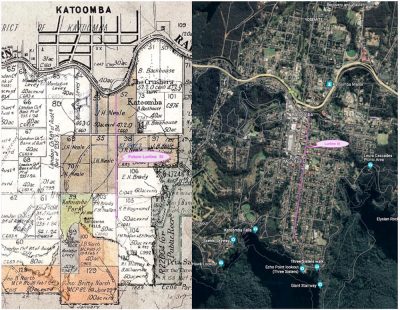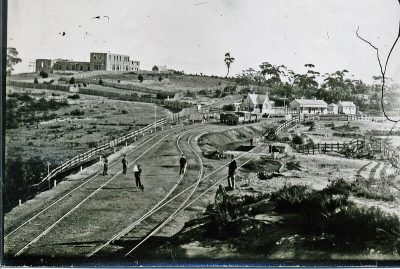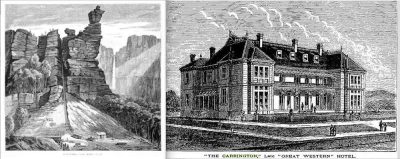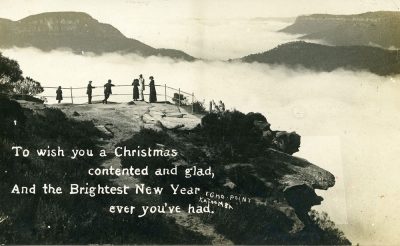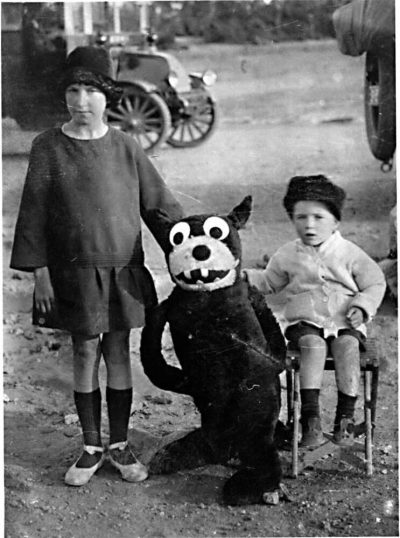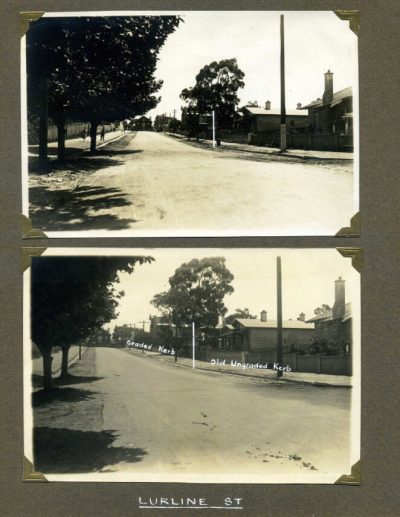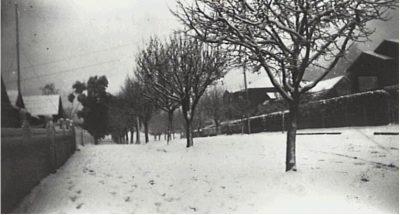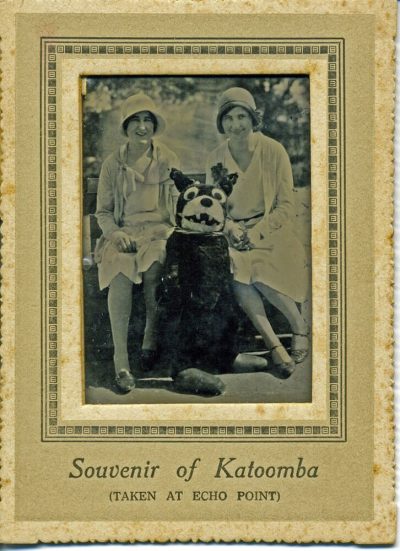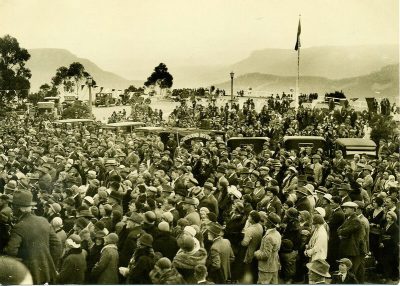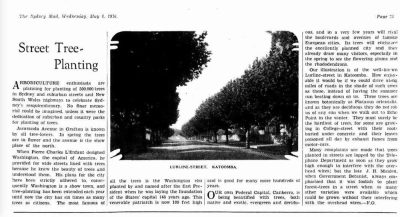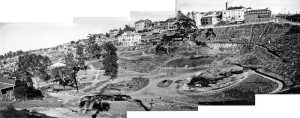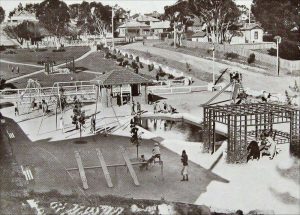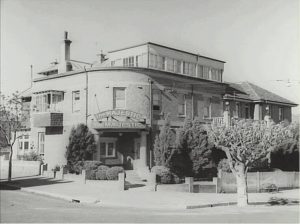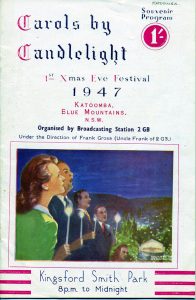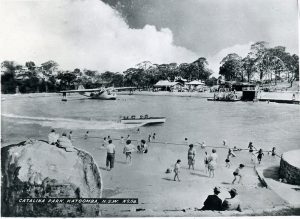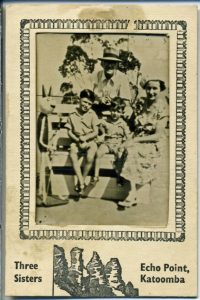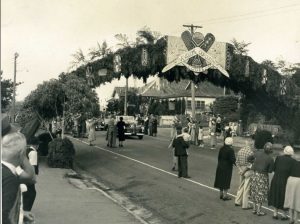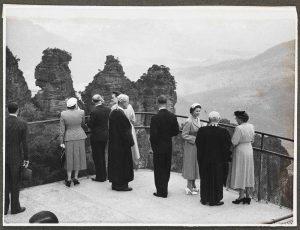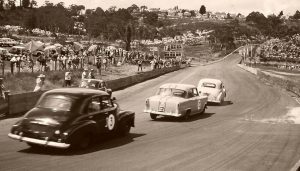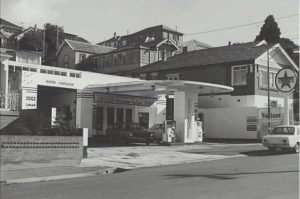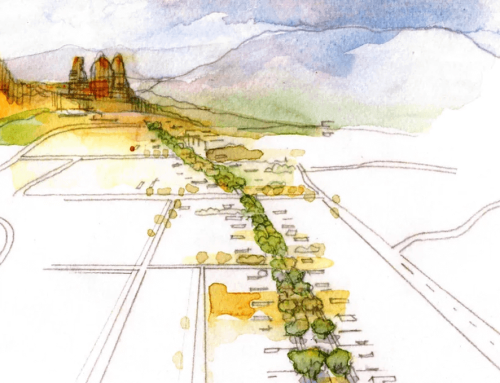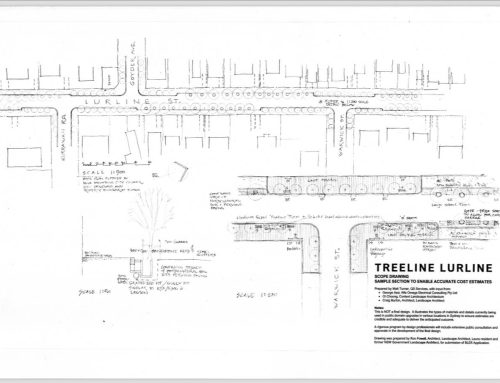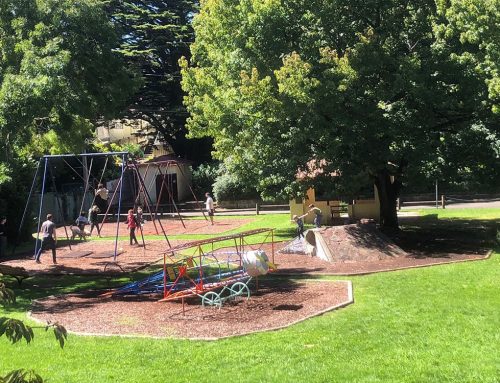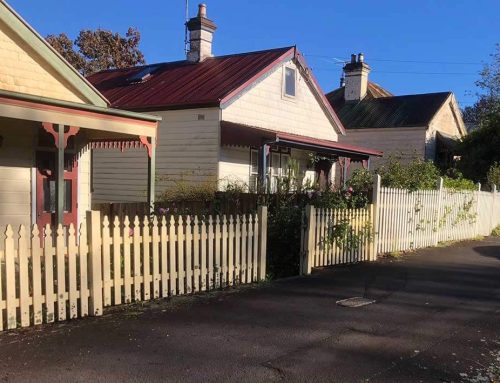A Short History
1868 Blue Mountains Railway from Sydney to Mount Victoria is completed. A quarry at “The Crushers”, 3336 feet above sea level, supplies sandstone for the upper mountains rail construction and maintenance.
1870s Coal and kerosene shale mining begin in the Jamison Valley below the Crushers and in neighbouring Megalong Valley. Mining settlements attach to each.
1876 A railway platform is built at the Crushers.
1876 Mining entrepreneur John Britty North and former butcher-cum-MP James Henry Neale squabble over boundaries of land portions at the Crushers that they seek to acquire on the basis of terra nullius, ‘no one’s land’ (Crown Land Acts 1861).
1877 James Neale acquires 400 acres in land grants including 50 free acres for his military service and 350 acres at £1 per acre. He pays 25% deposit with an interest-free period of three years to repay the remainder. The land covers much of modern Katoomba and some of Leura. Neale also wins the boundary dispute on the proviso he allows John North access through his land to transport coal to the rail line.
1878 The Crushers is re-named Katoomba. Neale claims credit and says that he learned the name from a local Kanimbla woman who said it means “falling shining water”. Gundungurra people have since advised that Katoomba or Goodoomba refers to an edible fern.
1878 John Britty North registers the Katoomba Coal Company. His coal rail from the valley floor to cliff-top is extended along an elevated tramway to “North’s Siding” beside Katoomba station.
1880 James Neale secures a Katoomba postal service.There are two registered addresses, his and the station masters.
1881 Neale sells his 50-acre Land Portion 53 for £7 per acre to Frederick Clissold, an English-born Sydney wool merchant.
1881 Clissold subdivides Portion 53 into 78 lots along three roads named Lurline, Katoomba and Parke. These run north-south from the train line and Bathurst Road to Waratah Street at the southern end of the portion. This establishes Katoomba town centre as it is today. ‘Lurline’ was a Queensland grazing station named after the owner’s daughter. Clissold is thought to have had business interests there.
1881 Construction starts on the luxury hotel in the top corner of Portion 53 next to the railway station.
1882 John North and his son take up 1392 acres on the western side of the Jamison Valley as “mineral conditional” purchases after kerosene shale is prospected.
1883 The Great Western Hotel is opened by owner Harry Rowell.The grand Victorian building has 59 rooms and is quickly and lavishly expanded.
1886 The Great Western is renamed the Carrington Hotel by new owner Frederick Charles Goyder in honour of NSW Governor Lord Carrington . The number of rooms has more than doubled. The new living areas include a music room and grand dining room.
1889 Katoomba Municipal Council becomes the first local government in the Mountains. It encompasses the Katoomba-Leura area.
1890 Carrington owner Frederick Charles Goyder is elected mayor.
1890 Tri Saxa (“Three Stones”) are renamed the “Three Sisters”. The First Nations name of the formation is never recorded.
1892 Katoomba Coal & Shale Company goes into liquidation. Its Narrowneck mining operations close.
1897 Gundungurra people of the Megalong Valley move permanently to an ancient summer campsite at the headwaters of Katoomba Falls after the closure of the Narrowneck mine removes casual work opportunities for them. Government land grants to white farmers make their traditional life in the valley impossible.
In ‘the Gully’ below the railway line and Carrington Hotel, they hunt and gather food and trade with and labour for Katoomba’s white community. Over time, poor white people also settle there.
1900 Federal Pass is opened. The new bushwalking track for Australia’s Federation Pass stretches from Leura Cascades to Katoomba Falls near the coal mine. It traverses the cliff base beneath Echo Point.
1903 Katoomba Coal Mine closes for the first time.
1905 Katoomba & Leura Tourist Association is established by local businessmen, a number of whom are also aldermen (councillors).
1905 Katoomba Municipal Council plant an avenue of London Plane trees along Lurline Street at 33 feet (10m) intervals with a budget of £20 ($40). There is controversy about the project and the cost and quality of the tree-guards.
1908 Echo Point at the end of Lurline Street is purchased by the State Government from Sir Frederick Darley’s Lillianfels Estate.
1908 Photographer and printer Harry Phillips (1873-1944) sets up shop in Katoomba. Over the next three decades, his romantic cloud and landscape photography, postcards and view books promote Katoomba-Leura scenery, especially the Three Sisters at Echo Point.
1910 A power station at the back of the Carrington Hotel is opened providing the first electricity to the hotel, Katoomba and other Blue Mountains towns. It creates a local market for Katoomba coal and powers the town’s burgeoning night life of dancing, singing, and picture shows after a day of bushwalking, tennis and croquet.
The power station’s brick chimney remains today as Katoomba’s highest landmark. Like the hotel, it is State heritage listed.
1910s Guesthouses and residential flats become a feature of Katoomba and the top of Lurline Street including the Mount View, later the Cecil, at 25 Lurline (1912) and Sans Souci, later Astor House, at 65 Lurline. These accommodate the State’s growing middle class using the rail service and new car transport.
1912 The Three Sisters feature on the cover of the Official Tourist Guide for Katoomba-Leura replacing Orphan Rock above Katoomba Falls as the local landmark.
1912 John Howie, master builder and stone mason of Sydney’s Central Railway Station and the GPO in Martin Place, builds his gracious Federation home Cathkin Braes at 148 Lurline Street (now SteelReid Studio).
1914 Ernest and Mary (May) Hudson buy land at the top of Lurline Street. These eleven lots at the northern end of James Neale’s original Portion 52 become known as Hudson’s Gully. Ernest is a prominent local businessman and sportsman.
1916-17 May Hudson builds Wadi Shaifa at 2 Lurline Street while her husband Ernest is serving with his horse Tango in the Australian Light Horse Brigade in World War I. The three storey mediterranean style house is named after a steep watercourse in Egypt about 150 km west of El Alamein to commemorate a battle where Hudson and Tango served.
1916-18 The Giant Stairway from Federal Pass up to Echo Point is commenced under the vision and supervision of Council’s Chief Ranger Jim McKay. The project is abandoned by the Council two years later as too difficult and expensive.
1921 Katoomba Council accepts four acres of land in front of Wadi Shaifa at 2 Lurline Street donated by May Hudson for the purpose of a public park. Mrs Hudson begins renting out Wadi Shaifa as holiday-let apartments. She is now a widow. Ernest died of double pneumonia in Palestine in 1918.
1920s Another wave of guesthouses open in Lurline Street in new and repurposed properties including, amongst others: the Clarendon (1921), Villers Bret (1921; now the site of RSL car park), the Majestic (now affordable seniors housing), Felton Woods Manor (now Hotel Blue), Rubyston (1921, now Pins restaurant) and the Eldon (1924, now vacant and derelict).
These establishments are most often owned or leased and run by women.
1926 The Felixman of Echo Point Welsh-born Dan Evans (1883-1961) begins photographing visitors with a large doll of Felix the Cat, the first animated film character created in Hollywood in 1919 by Australian Pat Sullivan.
Evans and his camera will be a fixture at Echo Point until 1960. Mickey Mouse, the Disney “copy cat” of Felix, makes occasional appearances but the Mountain Devil eventually usurps both as the preferred photographic model.
1926 Bushwalkers hitch a lift up from the Federal Pass to the cliff-top on the Katoomba Colliery‘s electric cable railway. The practice is quickly trending.
1932 The Echo Point Projecting Platform and Giant Stairway down to Federal Pass are opened by the NSW Premier Sir Bertram Stevens with a huge crowd and media. The precipitous Stairway of 933 stone and ladder steps down the cliff-face was completed under the supervision of Council’s Chief Ranger Jim McKay.
1933 The Katoomba Colliery builds a dedicated passenger carriage, called “the Mountain Devil”, on its electric cable railway to cater for the regular passenger service of bushwalkers up from the Federal Pass.
A Mountain Devil doll reminiscent of a seed pod of the local “Mountain Devil” plant (Lambertia formosa) eventually takes over from Felix the Cat at Echo Point. Katoomba school children learn how to make mountain devils out of pipe cleaners.
1934 Lurline Street Park is re-named Bert Hinkler Memorial Park in honour of the pioneer Australian aviator and inventor who made the first solo flight from England to Australia in 1928. Hinkler was killed in 1933 in a plane crash in Italy. A playground and toilets are installed.
1935 Katoomba Council begins clearing and landscaping ‘Hudson’s Gully’, the four acre frontage of Wadi Shaifa at 2 Lurline Street donated by Mrs Hudson in 1921.
The new park is designed by Mr Kerr of Sydney Botanical Garden and laid out by Katoomba Council’s head gardener Robert Robinson with labourers on unemployment relief. It is initially named Jubilee Park to commemorate King George V’s silver jubilee.
1936 Jubilee Park is renamed Kingsford Smith Memorial Park in honour of the pioneer Australian aviator who made the first trans-Pacific flight from the USA to Australia in 1928 and disappeared while flying over the Bay of Bengal in 1935. Remnants of the plane washed up years later.
1936 The Sydney Mail features the avenue of London Plane trees on “well-known Lurline Street in Katoomba” to promote national street tree planting.
1940 Kingsford Smith Memorial Park is officially opened. A sandstone entrance pavilion features a scale model of Kingsford Smith’s plane. There is an open air stage. During the 1940s there are nine gardeners.
1945 Katoomba Coal Mine closes for the last time following the shutdown of the Carrington powerhouse for local electricity supply.
The old coal train from the cliff base is bought by Harry Hammon for its Scenic Railway service, ‘the steepest passenger railway in the world’. Hammon expands the business to include a skyway cable car.
1946 Catalina Tourism Park is established by damming the creek above Katoomba Falls. A Catalina flying boat is placed in the middle of the new ornamental lake. Visitors pay to climb in while the plane is rocked by the waves from a circling motorboat. A miniature train, ferris wheel, small cinema and tea rooms add to the entertainment.
1947 The first Christmas Carols at Kingsford Smith Park are hosted and broadcast by 2GB.
1949 A story about the Three Sisters is published by Mel Ward, owner of the Pyala Museum at the Hydro Majestic Hotel in Medlow Bath (later at Echo Point Plaza). Mr Ward says the story was told to him by Gundungurra people. It is quickly absorbed into the tourism effort.
1952 Catalina Tourism Park closes. The Catalina flying boat and other entertainment are removed and the Government buys the park land.
1954 Queen Elizabeth II visits the Blue Mountains by Royal Train and disembarks for 55 minutes during the first visit of a reigning monarch to Australia. The Queen is driven along Lurline Street lined with thousands of waving adults and children and under an arch of native flora and pseudo-Aboriginal artefacts for an 11-minute Civic Reception at Echo Point. The projecting look-out is re-named Queen Elizabeth II Platform.
1957-9 The Catalina Raceway is opened in the Gully above Katoomba Falls. The homes of the, mostly Aboriginal, Gully community, are demolished and the community displaced. The home of Digger and Joan Cooper and their nine children burns down after they refuse to move.
c. 1957-9 Lurline Street Plane trees are removed by the Council.
1985 The Carrington Hotel closes.
1991 Restoration of the Carrington Hotel begins under new owners.
1994 Katoomba’s inaugural Winter Magic festival suggested by artist and Council cultural officer John Ellison is organised by the local community and attended by around 2000 people.
1995 Echo Point Plan of Management Draft Report for BMCC identifies Lurline Street as “the major route to Echo Point, a premier tourist attraction, and the most significant gateway within the Blue Mountains.”
It recommends “streetscape improvements including tree planting and upgrading street furniture to improve the character of the primary access…”
1996 The inaugural Blue Mountains Music Festival (originally the “Blue Mountains Folk Festival”) on Lurline Street is attended by 550 people. It is organised by Bob Charter owner of the Clarendon Guesthouse and local musician Al Ward. It is staged in the Clarendon, RSL Club and Katoomba Public School directly behind.
1998 The Carrington Hotel re-opens in time for Christmas with owners Mark Jarvis and Michael Brischetto. The restoration and renovations will be ongoing.
1998 Echo Point major upgrade is started. The recommendations for Lurline Street in the 1995 Draft Plan of Management are ignored.
1998 Plans for Blue Mountains Cultural Centre in Katoomba are initiated by Council.
2000 Greater Blue Mountains Area is declared a World Heritage site by the United Nations Environmental, Scientific and Cultural Organisation (UNESCO) in recognition of its significant natural values.
2003 Echo Point upgrade is completed and officially opened. The power lines are undergrounded and street trees planted for the last block at the end of Lurline Street named Echo Point Road.
2009 Katoomba resident Marie Wood approaches local councillors to re-plant trees in Lurline Street. A feasibility study is undertaken.
Lurline Street Tree Planting Feasibility Study by BMCC Principal Urban Designer Susan Bell recommends a major project of street tree planting with undergrounding of powerlines, whole-of-precinct renewal and water sensitive urban design. The councillors respond by resolving that “a comprehensive improvement plan” will be prepared for possible resourcing over the next ten years.
2010 Carrington Cellars & Deli opens in the renovated former Katoomba Power Station.
2012 Blue Mountains Cultural Centre opens next door to the Carrington and above Coles Supermarket. It includes a Regional Gallery, World Heritage Blue Mountains interpretative centre, Katoomba Library, meeting rooms, shop and cafe.
2014 Echo Point and the Three Sisters is declared an Aboriginal Place by NSW Government under the National Parks and Wildlife Act 1974 (NSW) following a nomination by Gundungurra Aboriginal Heritage Association.
2015 Lurline Street (Waratah to Merriwa Street ) Landscape and Street Tree Planting Plan is commissioned by the Council and prepared by landscape architects Craig Burton and Ron Powell. Katoomba Chamber of Commerce & Community and Katoomba RSL Club in Lurline Street participate as “stakeholders”.The Plan supports and develops the 2009 Feasibility Study recommendations.
2017 Winter Magic is attended by an estimated 50,000 people. It is the last year of the Grand Parade. Council is now focused on reining in NSW’s largest one-day community festival. Over the next four years, Winter Magic suffers death by a thousand cuts including COVID.
The Blue Mountains Music Festival continues as a ticketed event in the Lurline Street block of venues with a cap of 4000 attendees and impressive line-ups of local, national and international performers.
2018 Local writer and artist Lowell Tarling creates a poster and writes letters about planting trees on Lurline Street. He talks to Councillor Kerry Brown. They both talk to people who talk to other people. Lowell’s friend, watercolorist and architectural illustrator David Wardman illustrates the vision.
2019 Treeline Lurline Bole Team (working group) is established in January under the auspice of the Katoomba Chamber of Commerce & Community with residents, business leaders, councillors and representatives of local arboriculture, tourism, arts and heritage groups and First Nations.
Treeline Lurline facebook, website, banner are fliers are created with David Wardman’s illustrations as the vision and ‘branding.’ There is a petition, Lurline street stalls and a public form at the Carrington Hotel.
BMCC resolves to support the Treeline Lurline Project and the efforts of Katoomba Chamber and its associate groups to seek funding.
2020 BMCC Local Strategic Planning Statement includes Priority Action 7.8: “investigate opportunities for active transport connections and public space / streetscape enhancement between town centres and significant tourism destinations, including a focus on Lurline Street in Katoomba.”
2020-21 Treeline Lurline professionals donate their time and expertise to prepare investigations, studies and costings for a business case and grant application.
Feb 2022 Grant of $4 million is awarded by the Federal Government to Katoomba Chamber to complete Stage One of the Treeline Lurline Project in partnership with BMCC, the National Trust Blue Mountains branch, Blue Mountains Tourism and Upper Mountains Arborist Alliance.
July 2022 Treeline Lurline Steering Committee and Blue Mountains City Council appoint a joint Project Management Team and a Project Manager for Stage One of the project.
1878 NSW Government Map of Katoomba Land Portions and Owners.
2018 Google map of the same area.
1881 Katoomba Station and Carrington under construction. Blue Mountains City Library.
1886 Katoomba Coal Company operations below Orphan Rock by Samuel Calvert and the Carrington Hotel promotional image.
1912 (circa) Christmas postcard by photographer Harry Phillips. Blue Mountains Library.
1926 Gwen Parry and brother Ted with Felix the Cat at Echo Point. Blue Mountains Library.
1925-27 Lurline Street before and after works, City Council Engineers Album, Leslie Graham, Blue Mountains Library.
1925-27 Lurline St looking north before and after works, City Council Engineers Album, Leslie Graham, Blue Mountains Library.
1929 Lurline In Snow, Blue Mountains City Library.
1930 May Kelso and Friend with Felix the Cat at Echo Point, Blue Mountains Library Local Studies.
1932 Giant Stairway opening at Echo Point. Blue Mountains Library.
1936 Sydney Mail. Blue Mountains Library.
1938 Kingsford Smith Park looking across to Lurline Street, Blue Mountains Library Local Studies
1940s Bert Hinkler Memorial Park
1946 The Majestic Guesthouse cnr Lurline and Waratah, Blue Mountains Library
1947 Carols by Candlelight Kingsford Smith Park, Blue Mountains Library
1950s Catalina Park, Katoomba
1954 Jim, John, May, Basil Low at Echo Point with the Mountain Devil
1954 Queen Elizabeth II being driven down Lurline Street to Echo Point, Blue Montains Library, Local Studies
1954 Royal visit to Echo Point, NSW State Library
1963 Catalina Park Raceway Katoomba
1971 Solomons Garage Lurline St, Blue Mountains Library

